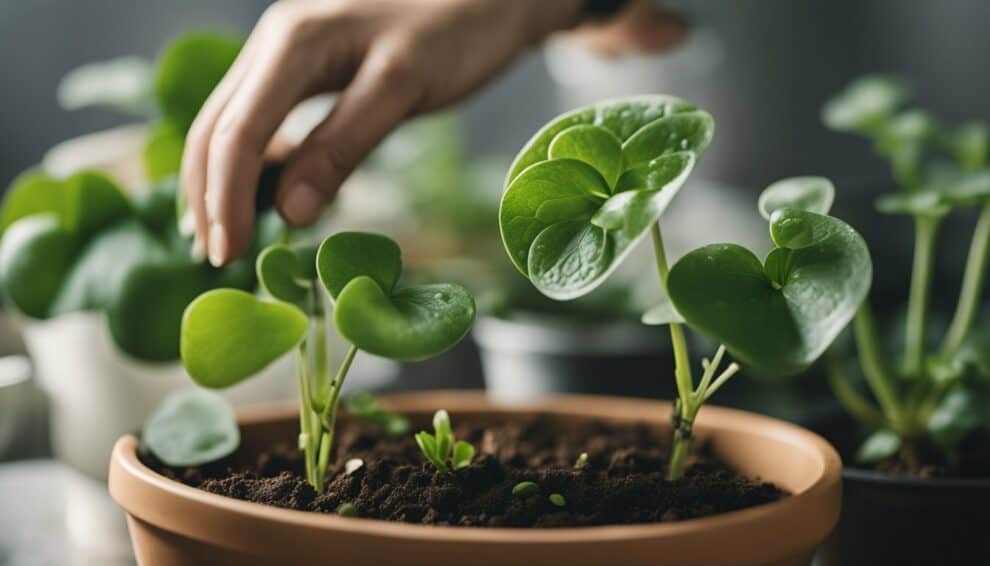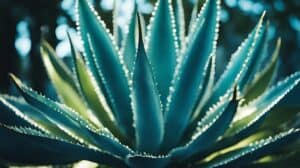Pilea Peperomioides, also known as the Chinese Money Plant, is a popular houseplant that has taken the internet by storm due to its unique appearance and easy care.
This plant is native to China and is known for its round, flat, coin-shaped leaves that grow on long, thin stems.
Pilea Peperomioides is a great plant for beginners and experienced gardeners alike, and its propagation is an excellent way to expand your plant collection.

Propagation is the process of creating new plants from existing ones, and Pilea Peperomioides is an excellent plant for propagation.
This plant is relatively easy to propagate, and once you have learned how to do it, you can create an endless supply of new plants.
Propagation is also a great way to share your love for this plant with friends and family.
In this article, we will discuss the different methods of Pilea Peperomioides propagation and provide you with the information you need to grow your own Chinese Money Plant.
Understanding Pilea Peperomioides
Species Overview
Pilea Peperomioides, also known as the Chinese Money Plant, is a popular houseplant that is native to southern China.
It is a member of the Urticaceae family and is characterized by its round, coin-shaped leaves that grow on long, thin stems.
The plant has become a favorite among plant enthusiasts due to its unique appearance and ease of care.
Ideal Growing Conditions
To ensure healthy growth and development of the Pilea Peperomioides, it is important to provide it with the ideal growing conditions.
The following table provides an overview of the ideal growing conditions:
| Growing Condition | Ideal Range |
|---|---|
| Light | Bright, indirect light |
| Temperature | 60-75°F (15-24°C) |
| Humidity | Moderate to high |
| Soil | Well-draining, rich soil |
| Watering | Allow soil to dry out slightly between waterings |
| Fertilizer | Monthly, during growing season |
It is important to note that the Pilea Peperomioides is sensitive to overwatering and should not be placed in direct sunlight.
Additionally, the plant benefits from occasional pruning to promote new growth and maintain its shape.
By understanding the species overview and ideal growing conditions of the Pilea Peperomioides, plant enthusiasts can successfully propagate and care for their own Chinese Money Plant.
Propagation Basics

When to Propagate
Pilea Peperomioides, also known as the Chinese Money Plant, can be propagated at any time of the year.
However, it is best to propagate during the spring and summer months when the plant is in its active growth phase.
This will increase the chances of success and ensure that the new plants have enough time to establish themselves before the colder months.
Tools and Materials Needed
To propagate Pilea Peperomioides, you will need the following tools and materials:
- Sharp scissors or pruning shears
- A clean, sharp knife
- A small pot or container
- High-quality potting soil
- A rooting hormone (optional)
- A spray bottle filled with water
Before starting, make sure that all your tools and materials are clean and sterile to prevent the spread of disease.
It is also a good idea to use gloves to protect your hands.
Once you have everything ready, you can start propagating your Pilea Peperomioides.
Propagation Methods

Pilea Peperomioides, also known as the Chinese Money Plant, is a popular houseplant that is easy to propagate.
There are three common methods of propagation: leaf cutting, division, and rooting in water.
Leaf Cutting
One of the easiest ways to propagate Pilea Peperomioides is through leaf cuttings.
Simply cut a healthy leaf from the mother plant, making sure to include the petiole or stem.
Place the leaf cutting in a pot filled with well-draining soil and keep the soil moist.
After a few weeks, roots should begin to form, and a new plant will emerge.
Division
If your Pilea Peperomioides has outgrown its pot, it may be time to divide the plant.
Gently remove the plant from its pot and separate the root ball into smaller sections, making sure each section has its own stem and leaves.
Repot each section into its own pot with fresh soil, and water thoroughly.
Rooting in Water
Another popular method of propagating Pilea Peperomioides is by rooting the stem cuttings in water.
Simply cut a healthy stem from the mother plant and place it in a jar filled with water.
Keep the jar in a bright, indirect light and change the water every few days.
After a few weeks, roots should begin to form, and the cutting can be planted in soil.
Overall, Pilea Peperomioides is a great plant for beginner gardeners because of its easy propagation methods.
With a little patience and care, you can grow your own Chinese Money Plant and enjoy its unique, round leaves in your home.
Aftercare for Propagated Plants

Potting and Soil Requirements
Once the Chinese Money Plant cuttings have rooted, they should be potted in a well-draining soil mix.
A mixture of equal parts potting soil, perlite, and sand is ideal.
The pot should have drainage holes to prevent water from accumulating in the soil, which can lead to root rot.
It is important to choose a pot that is slightly larger than the root ball, as a pot that is too large can lead to overwatering and root rot.
The pot should also be made of a breathable material, such as terracotta, to allow for proper air circulation.
Watering and Feeding
Proper watering is crucial for the health of propagated Chinese Money Plants. They should be watered when the top inch of soil is dry to the touch.
Overwatering can cause root rot, while underwatering can cause the leaves to wilt and turn brown.
A balanced fertilizer should be applied every two weeks during the growing season to promote healthy growth.
It is important to follow the instructions on the fertilizer package, as over-fertilizing can burn the roots and damage the plant.
Long-Term Care
As the propagated Chinese Money Plant grows, it may need to be repotted into a larger pot.
This should be done in the spring, before the growing season begins.
Regular pruning can help to maintain the plant’s shape and promote healthy growth.
Any dead or yellowing leaves should be removed promptly to prevent the spread of disease.
Chinese Money Plants prefer bright, indirect light, but can tolerate lower light conditions.
They should be kept away from direct sunlight, as this can scorch the leaves.
With proper care, propagated Chinese Money Plants can thrive and continue to bring joy to their owners for years to come.
Frequently Asked Questions

How can I propagate a Chinese Money Plant from a leaf cutting?
Propagating a Chinese Money Plant from a leaf cutting is possible, but it can be a slow process.
Take a healthy leaf from the parent plant and make a clean cut at the base of the stem.
Place the leaf in a small pot with moist soil and cover it with a plastic bag to create a humid environment.
Keep the soil moist and the plant in a bright, indirect light. After a few weeks, roots should begin to form and a small plant will emerge.
What is the best method to propagate a Chinese Money Plant from its stem?
The best method to propagate a Chinese Money Plant from its stem is by taking stem cuttings. Choose a healthy stem and cut it just below a leaf node.
Remove the lower leaves and place the cutting in water or moist soil. Keep the soil moist and the plant in a bright, indirect light.
After a few weeks, roots should begin to form and a new plant will emerge.
Can I root a Chinese Money Plant in water, and if so, how?
Yes, it is possible to root a Chinese Money Plant in water. Take a healthy stem cutting and remove the lower leaves.
Place the cutting in a jar of water and keep it in a bright, indirect light. Change the water every few days to prevent bacteria growth.
After a few weeks, roots should begin to form and a new plant will emerge.
What steps should I follow to separate and transplant Chinese Money Plant babies?
To separate and transplant Chinese Money Plant babies, gently remove them from the parent plant and carefully untangle their roots.
Plant each baby in its own pot with fresh soil and water thoroughly.
Keep the plants in a bright, indirect light and water when the soil feels dry to the touch.
Is it possible to grow a new Chinese Money Plant from cuttings?
Yes, it is possible to grow a new Chinese Money Plant from stem cuttings or leaf cuttings. Follow the steps outlined above for the respective method.
What’s the process for propagating a Chinese Money Plant in soil?
To propagate a Chinese Money Plant in soil, take a stem cutting or leaf cutting and plant it in moist soil.
Keep the soil moist and the plant in a bright, indirect light. After a few weeks, roots should begin to form and a new plant will emerge.













